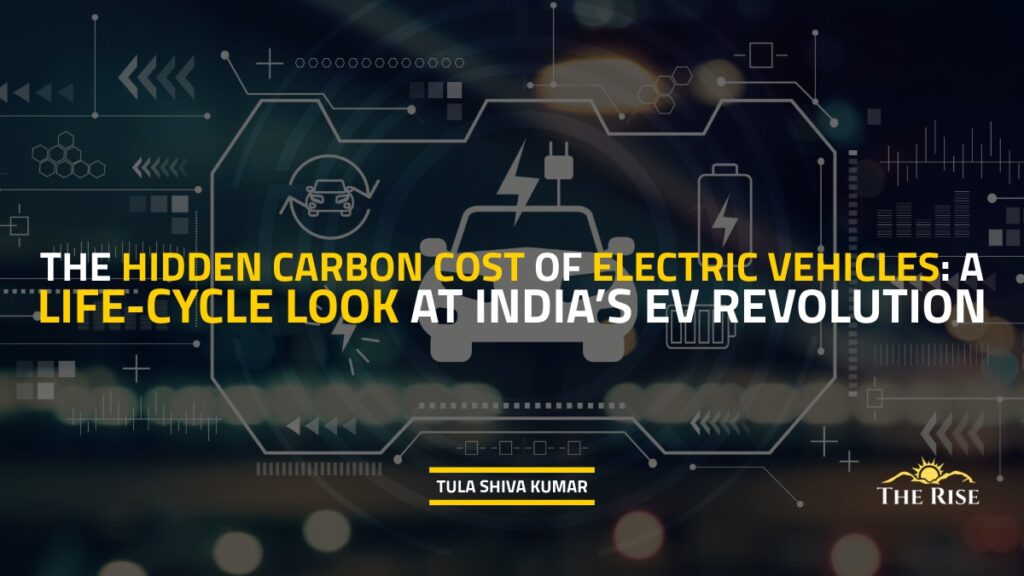Electric vehicles (EVs) represent a pivotal shift in the automotive industry, aimed at reducing greenhouse gas emissions and dependence on fossil fuels. However, a comprehensive life-cycle assessment (LCA) reveals that while EVs deliver significant environmental benefits, they also pose substantial upstream and downstream challenges.
India’s electric-mobility moment has arrived. At the recently held CII Delhi EV Summit, the industry leaders and government officials spotlighted the country’s aim to leapfrog into the future of transport. As the electric vehicle (EV) adoption surges, passenger EVs now account for around 5 per cent of the total vehicle sales, nearly double what it was a year ago. At the same time, globally EV sales now account for over one-quarter of the new car sales worldwide.
In the automotive industry, electric and hybrid engines are increasingly being viewed as the future of mobility. Since fully electric vehicles do not emit any tailpipe exhaust, electric motors appear far more efficient than conventional gasoline or diesel combustion engines. They also reduce dependence on fossil fuels, offering a promising path towards cleaner transportation.
Also Read: Why India’s Urban Transport Fails: Insights from TheRise Survey on Commuters, Traffic, and Safety
However, despite the rapid acceleration towards electric mobility, they also prompt critical questions about the hidden environmental costs embedded in the EV life-cycle.
In order to power electric vehicles (EVs), additional electricity has to be generated, which is done using a variety of energy sources that have varying effects on the environment. To truly assess how eco-friendly EVs are, it is essential to examine the entire life cycle of the vehicle, from the extraction of raw materials to manufacturing, use, and end-of-life recycling and disposal. This comprehensive approach, known as Life-Cycle Assessment (LCA), helps determine the overall environmental footprint of electric vehicles.
While EVs are marketed as zero-emission vehicles, they are not entirely free from contributing to climate change. Even though they produce no direct tailpipe emissions, EVs are indirectly responsible for pollution at various stages of their life cycle. The environmental impact of EVs can be divided into three main phases, as outlined below:
- Upstream emissions– Resulting from the mining and processing of raw materials, especially lithium, cobalt, and nickel used in battery production.
- In-use emissions – Depending on the regional electricity grid carbon intensity, meaning EVs charged using coal-based electricity still have a significant carbon footprint.
- Downstream emissions – Associated with battery manufacturing, end-of-life disposal, and recycling inefficiencies.
Recent studies indicate that manufacturing a single Electric Vehicle can release up to 46% of its total life cycle carbon dioxide emissions. These emissions are released before the vehicle even hits the road. Therefore, as the demand for EVs rises, so does the carbon footprint that is associated with their production.
| Life Cycle Stage | Emissions Contribution (% of total) |
| Battery Production | 30–50% |
| Vehicle Manufacturing | 10–20% |
| Electricity Use (charging) | 20–50% (varies by grid) |
| End-of-Life/Recycling | <5% (can be positive if efficient) |
Upstream emissions
Producing a standard EV can result in higher carbon emissions than producing a car that runs on gasoline. This is primarily due to additional energy required for battery production, especially in the stages of raw material extraction, processing, and cell manufacturing. The table mentioned below shows the detailed explanation of the above counterintuitive:
Emissions During EV Battery Production (Upstream Phase)
| Steps | Process | Type of pollution | Estimated emission |
| 1 | Raw Material Extraction | CO₂,air/water/soil pollution, habitat loss | 15–40 kg CO₂/kg material; high water use |
| 2 | Material Processing | CO₂, chemical waste, SOx, HF | 20–50 kg CO₂/kWh; toxic by-products |
| 3 | Cathode/Anode Production | CO₂, VOCs, solvent emissions | 30–70 kg CO₂/kWh; solvent waste |
| 4 | Cell Manufacturing | CO₂, energy use, VOCs | 40–70 kg CO₂/kWh; high energy demand |
| 5 | Battery Pack Assembly | CO₂, packaging waste | 10–20 kg CO₂/kWh |
| 6 | CO₂, air/water/soil pollution, habitat loss | CO₂, SOx, Nox | 5–15 kg CO₂/kWh[SY1] |
The table illustrates the significant carbon burden associated with battery production. Each stage—from raw material extraction to logistics—adds incrementally to the total emissions footprint. Overall, producing a typical electric vehicle (EV) battery with a capacity between 40 and 100 kWh can generate anywhere from 60 to 150 kg of CO₂-equivalent per kilowatt-hour of capacity. This means that for a mid-sized 75 kWh battery, the total emissions released during manufacturing alone can range between approximately 4.5 and 11.25 tons of Carbon dioxide. In other words, nearly half of an EV’s total life-cycle emissions may be locked in before the vehicle even leaves the factory floor.
Beyond emissions, the extraction of key battery minerals such as lithium, cobalt, and nickel poses serious environmental and ethical challenges. Lithium leach fields use chemical solutions to extract lithium, but these chemicals can leak into the ground, contaminating nearby water sources and farmland. During the process, hazardous chemicals like Hydrogen fluoride and phosphorus may be released into the atmosphere, endangering the health of nearby residents and adding to air pollution.
Similarly, around 70% of the world’s cobalt comes from the Democratic Republic of the Congo (DRC), where mining operations are linked to water pollution and unsafe labour conditions. Nickel extraction, concentrated in Indonesia, Australia, and Russia, produces sulfur dioxide and heavy metals that contribute to acid rain and ecosystem damage. Together, these impacts highlight that while EVs reduce tailpipe emissions, their supply chains remain deeply resource-intensive and ecologically disruptive.
In-Use emissions
An EV has no tailpipe emissions during operation (i.e, no direct CO2 from burning fuel), but the electricity that is used for powering the vehicle is mostly generated from fossil fuels. India aims to have 30% of all vehicles on the road to be electric by 2030 (Ministry of Heavy Industries, 2021). However, India’s reliance on coal-fired power plants presents a significant challenge to the environmental efficacy of this transition, with over 70% of India’s electricity needs still being derived from coal-based thermal power plants, greatly increasing the grid’s carbon intensity.
Downstream emissions and Battery End-of-Life
Automakers are required to make sure that at least 95% of every vehicle they produce is recycled, repurposed, or recovered, per the Society of Motor Manufacturers and Traders (SMMT) 2023 Automotive Sustainability Report.
Batteries for electric vehicles typically last 15 to 20 years, and their “second life” begins when their performance falls or the State of Health (SoH) falls to around 70% or less. The SoH is the measure of a battery’s overall condition compared to when it was new, and when it declines below the threshold, the battery can no longer efficiently power a vehicle. At this stage, instead of being discarded, EV batteries are removed and repurposed for other energy storage applications.
These discarded EV batteries can be repurposed for a variety of energy storage applications, helping to extend their useful life and reduce environmental waste. They are commonly used to store renewable energy (solar and wind), which can then be released during peak demand periods or to smooth fluctuations in power supply. Examples include rooftop solar systems with battery backups or storing off‐peak grid power for later use.
Second-life batteries also play a key role in powering telecom towers, providing backup energy for commercial and residential buildings, and supporting rural electrification projects. In smaller EV segments such as two and three-wheelers, swapped battery modules can be refurbished and reused, with even battery-swap networks refurbishing or reassigning older batteries.
These secondary uses can extend a battery’s life by an additional 5–10 years, depending on usage patterns, environmental conditions, and charging behaviour. On average, EV batteries in India have a first-life of 6–10 years before their State of Health (SoH)drops to around 70–80%, at which point they are repurposed for second-life applications.
Comparisons to EVs and IC Engine Vehicles
| Factors | EVs | IC Engine vehicles |
| Tailpipe emissions | None | Lower (if the grid is clean) |
| Energy efficiency | Higher (~ 70-90%) | Lower (~ 20-30%) |
| Operating emissions | high CO2, NOx, pm | Consistently high |
| Lifecycle CO2 emissions | Usually lower | Consistently high |
| Recycling and end of life. | Emerging. | More mature system |
However, in recent decades, numerous commercial and pilot projects have emerged to capitalize on this potential. For example, MG Motor India, in partnership with Lohum, has begun converting used EV batteries into off-grid 5 kWh Battery Energy Storage Systems (BESS) for deployment in both urban and rural areas.
Electric vehicles (EVs) represent a pivotal shift in the automotive industry. However, a comprehensive life-cycle assessment (LCA) reveals that while EVs deliver significant environmental benefits, they also pose substantial upstream and downstream challenges. Despite these issues, the total life-cycle emissions of EVs remain lower than those of internal combustion engine vehicles, especially when powered by cleaner electricity grids.
To truly unlock the promise of electric mobility, the future must not only be electric, rather it must also be ethical, circular, and clean from mines to motor.
Tula Shiva Kumar is a TRIP Intern.
Mentored and Edited by Sneha Yadav.
References
- David Biello, “Electric Cars Are Not Necessarily Clean”, May 11, 2016, Scientific American.
- U.S. Energy Information Administration (EIA): Renewables became the second-most prevalent U.S. electricity source in 2020.
- Electric vehicles (combined): Where the Energy Goes: Electric Cars. Gasoline vehicles (combined): Where the Energy Goes: Gasoline Vehicles.
- Kara Anderson, “Harmful effects of our lithium batteries”, 24 July 2024, Greenly publication https://afdc.energy.gov
- Ankathi, S.K.; Bouchard, J.; He, X. “Beyond Tailpipe Emissions: Life Cycle Assessment Unravels Battery’s Carbon Footprint in Electric Vehicles.” World Electric Vehicle Journal 2024.
- Marek Guzek, Jarzy, Rafal, “Electric Vehicles—An Overview of Current Issues—Part 1—Environmental Impact, Source of Energy, Recycling, and Second Life of Battery”, 3 January 2024, Energies,2024.
- Rachael Nealer, David, and Anair. “Cleaner cars from cradle to grave.” Nov 2015.
- Auto Environmental Guide,2021.
- EV world Africa, 9 July 2025, and World Electric Vehicle Journal, 2025.
- “Beyond Tailpipe Emissions: The Hidden Carbon Footprint of Electric Vehicles and the Future of Transport,”july 9, 2025, EV world Africa.











